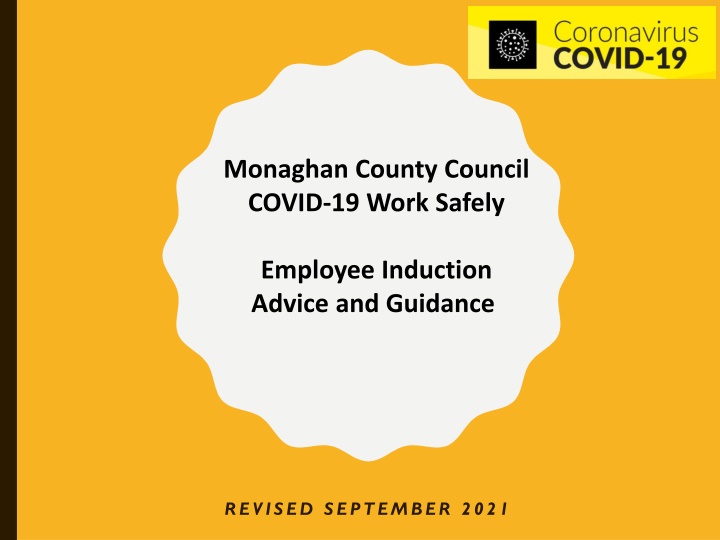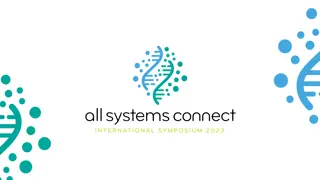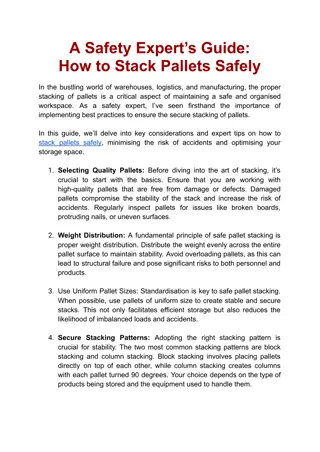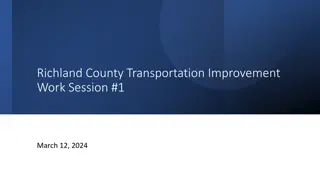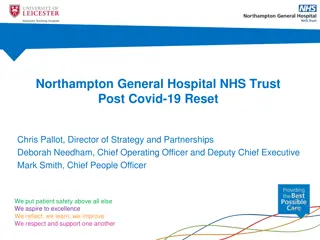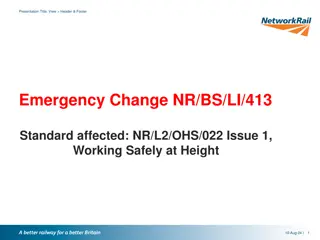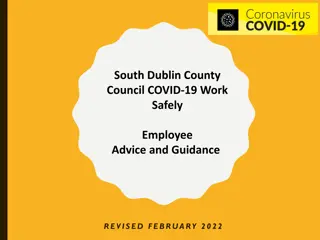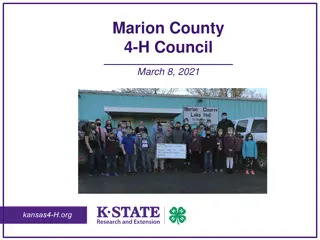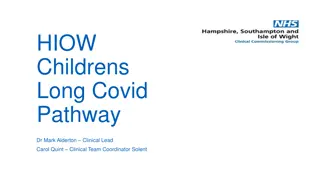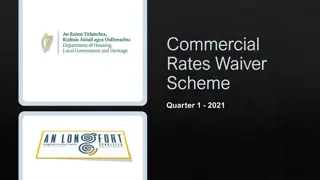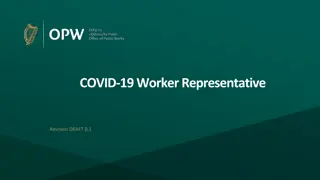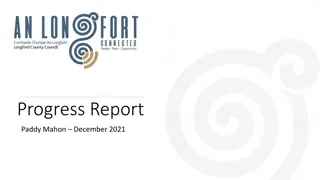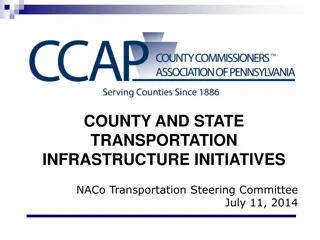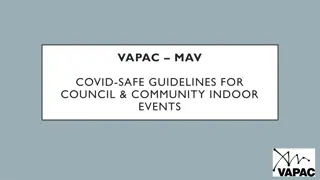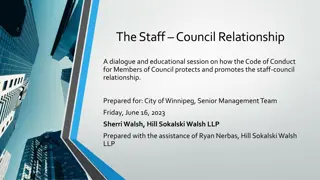Monaghan County Council COVID-19 Work Safely Guidelines
The Monaghan County Council provides updated guidelines for employees to work safely during the COVID-19 pandemic. Emphasizing collaboration between employers and workers, the document outlines key control measures, the importance of communication, and the shared responsibility in implementing preventative measures. It discusses the nature of COVID-19 transmission, the need for adherence to public health advice, and the role of both employers and employees in combating the virus.
Download Presentation

Please find below an Image/Link to download the presentation.
The content on the website is provided AS IS for your information and personal use only. It may not be sold, licensed, or shared on other websites without obtaining consent from the author.If you encounter any issues during the download, it is possible that the publisher has removed the file from their server.
You are allowed to download the files provided on this website for personal or commercial use, subject to the condition that they are used lawfully. All files are the property of their respective owners.
The content on the website is provided AS IS for your information and personal use only. It may not be sold, licensed, or shared on other websites without obtaining consent from the author.
E N D
Presentation Transcript
Monaghan County Council COVID-19 Work Safely Employee Induction Advice and Guidance REVISED SEPTEMBER 2021
INTRODUCTION The COVID-19 pandemic has impacted severely on every part of our society and our economy. We are living through a world crisis of an enormous scale. This has led to extraordinary demands and challenges for local authorities. However, local authorities have responded and as providers of essential services, have ensured that service provision has been maintained to the highest possible capacity during COVID-19. Work is a key part of life and it is important that we can continue to work safely. This induction is designed to provide information on the key control measures implemented by the Council and our responsibilities that will prevent the spread of COVID-19. New habits are already well-adopted which will continue to help us combat the virus. While the various vaccines and their delivery provide a clear pathway for us, we must continue to be adhere to public health advice.
The key to a safe workplace remains strong communication and a shared collaborative approach between employers and employees. Individual behaviour changes and cooperation across the Local Authority sector will continue to be critical to managing COVID-19 and to minimise the risk of COVID-19 transmission in our workplaces. . Individually we can take precautions, and these continue to be our first line of defence. No single measure, in isolation, will control the spread of COVID-19 and the most effective approach is one which involves a combination of societal and personal protective measures
WORKING TOGETHER TO SUPPRESS COVID-19 IN THE WORKPLACE This document reflects a shared collaborative approach between employers and workers and is key to protecting against the spread of COVID-19 in the workplace. Employers and employees will have regular engagement about COVID-19 and preventative measures in the workplace. The approach to COVID-19 will reflect the positive engagement which we have had with Trade Unions in the sector and their support for safety at work of their members. Local Authorities believe that we all as employers, Trade Unions and employees have a shared responsibility to implement the measures contained in this document in our place of work. A collaborative approach to the implementation of the protocol is essential to achieve success and maximum buy-in. Each Local Authority will appoint worker representatives charged with ensuring that COVID-19 measures are strictly adhered to.
CORONAVIRUS (COVID-19) To combat COVID-19, we must understand how it is spread and how to protect ourselves, our families, our colleagues and our community. How the virus is spread. Close Contact - COVID-19 is mainly spread through close contact and droplets that come from your nose and mouth, for example from someone who is talking loud, coughing or sneezing. This happens when people are within 1 to 2 metres of each other and is why keeping a 2 metre distance from other people is so effective in reducing the spread. Airborne Transmission this is the spread of a virus in tiny water particles, known as aerosols. COVID-19 can spread in crowded or poorly ventilated areas. To protect against airborne spread, keep indoor spaces ventilated by opening windows and doors when possible. Infected Surfaces - You can also get the virus from infected surfaces. For example, when someone sneezes or coughs, droplets with the virus can fall onto surfaces around them. If you touch that surface and then touch your eyes, nose or mouth, you come become infected too. Getting COVID-19 from surfaces is not as common as getting it through close contact with someone who has the virus but it is still important to wash hands properly As such we must all follow the public health advice and guidance, as well as any specific measures in place to help prevent the spread of COVID-19 in the work environment. and often and to clean surfaces.
COVID-19 SYMPTOMS The most common symptoms are: Cough: A new cough this can be any kind of cough not just dry Other symptoms may include: runny or blocked nose, nausea, vomiting or diarrhoea, aches and pains or tiredness, sore throat, and headache. You may not have all of these symptoms. It can take up to 14 days for symptoms to show. They can be similar to symptoms of cold and flu. If you are in doubt about any symptoms you have, phone your GP. Fever: High Temperature over 38o C or above Shortness of Breath or breathing difficulties Loss or change to your sense or smell or taste
COVID-19 SYMPTOMS WHAT TO DO? Remain vigilant - early intervention helps to prevent the spread of the virus. It is essential that you do not attend workplace if you are displaying any symptoms of COVID-19. This applies regardless of vaccination status. Immediately self isolate and make phone contact with your GP or HSE Helpline 1850 241 850 and notify Line Manager / Supervisor. An early diagnosis from your GP means you can get the help you need and avoid spreading the virus, if you have it. While awaiting the test result other people in your household may need to restrict their movements (stay at home). If your test comes back as positive for COVID-19 then you must self-isolate and follow the advice of Public Health. You will be contacted by HSE Public Health contact-tracers. Your close contacts will be identified, contacted and advised if they are close contacts and if they are not vaccinated, they will need to restrict their movements and get tested. However, if the close contacts are fully vaccinated and asymptomatic, they may not need to restrict their movements. All close contacts regardless of whether they are vaccinated or not need to self- isolate and get tested if they have symptoms suggestive of COVID-19.
IF YOU DEVELOP COVID-19 SYMPTOMS AT WORK While the advice is to not attend the workplace if you have any symptoms of COVID-19, it is important that you follow workplace isolation procedures should you develop symptoms of the virus while at work. Notify your Line Manager by phone immediately. Isolate from other staff. Wear a face covering/mask. Keep a distance of 2 metres from others. Go home as soon as it is safe to do so. If possible, do not use public transport to go home. Self isolate at home and phone your GP to arrange a test for COVID- 19. If you cannot go home immediately: Remain self isolating in the building and phone your GP Avoid touching people, surfaces and objects. Cover your mouth and nose with tissues when you cough or sneeze and bin these tissues in a waste bag.
CLOSE CONTACT AND CASUAL CONTACT Close Contact can mean: Spending more than a total of 15 minutes of face to face contact within 2 metres of someone who has COVID-19, indoors or outdoors, over a 24 hour period Living in the same house or shared accommodation as someone who has COVID- 19. Spending more than 2 hours in an indoor space with someone who has COVID-19 How you ll know if you are a close contact: You will usually find out if you are a close contact from: A text message from the contact tracing team The COVID Tracker App The public health team investigating confirmed cases within a specific setting. What close contacts need to do If you are a close contact of someone that tests positive for COVID-19, what you need to do depends on if you: have symptoms of COVID-19 are fully vaccinated against COVID-19 have a weak immune system had a positive COVID-19 PCR test in the last 9 months
CASUAL CONTACT You may have been in contact with someone with COVID-19, but you do not meet the definition to be a close contact above. This is a casual contact. If you are a casual contact you do not need to restrict your movements. Continue to follow advice on how to protect yourself and others. Please see HSE for further information Close contact and casual contact - HSE.ie
RETURN TO WORK PROTOCOL In the event of an employee being either a suspected / confirmed case of COVID-19 or a known close contact with a confirmed or suspected case, they must follow return to work protocols and follow public health advice in relation to when they can return to workplace. This includes completing the pre-return to work form, when requested to do so. Employees should have regard to any changes in their circumstances in relation to the questions on the form and notify their manager/HR immediately.
COVID-19 TRACKER APP The COVID Tracker is a free and easy-to-use mobile phone app that will: alert you if you have been in close contact with someone who has tested positive for COVID-19 advise you on what to do to protect yourself and others keep other app users safe by alerting them if you test positive for COVID-19 provide advice on what to do if you have symptoms Individuals can use the COVID Tracker app to: track how they are feeling each day find out if have symptoms of COVID-19 get advice quickly on what to do Logging symptoms each day can: help you remember when you first became unwell be a useful reminder if you need to later speak with your GP help you to get trusted advice quickly help to map and predict the spread of the virus The app is part of the HSE s contact tracing operation. This tool is invaluable for contact tracing where positive Covid-19 cases are identified in the community. The app can be downloaded from Apple s App Store or the Google Play Store .
PROTECTION AGAINST GETTING COVID-19 The best ways to prevent the spread of COVID-19 in a workplace or any setting is through prevention measures such as wearing masks/coverings, physical distancing, proper hand hygiene, respiratory etiquette, increasing ventilation and staff themselves deciding to be vaccinated. Hand Hygiene - Wash hands regularly and avoid touching your face and eyes with your hands. Use hand sanitiser where soap and water is not available. Many hand sanitisers are alcohol based and highly flammable. Do not use near heat or a naked flame. If hands are visibly dirty, wash hands with soap and water prior to using the sanitiser. Remember this should be for at least 20 seconds. Watch this short video demonstrating how to wash your hands properly, and help prevent the transmission of COVID-19: https://youtu.be/IsgLivAD2FE Cough Etiquette - when coughing / sneezing, cover your mouth and nose with your bent elbow or a tissue. Place used tissues into a closed bin and wash hands. Clean and disinfect frequently - touched objects and surfaces. Keep your environment clean.
PROTECTION AGAINST GETTING COVID-19 Unnecessary Contact - Do not shake hands or make unnecessary contact with other people, if possible. Physical Distancing - (also known as social distancing) aims, through a variety of means, to decrease or interrupt the spread of COVID-19. It does this by minimising contact between potentially infected individuals and healthy individuals. Physical distancing is one of the most important measures in reducing the spread of COVID-19. The current recommended distance to be maintained between people to minimise risk of transmission is 2 metres. It is important that you follow any measures put in place by your employer to maintain physical distancing. If your work activity is going to require close contact within 2 metres, STOP and ask your line manager / supervisor for advice. This will require a risk assessment resulting in additional protection measures.
PROTECTION AGAINST GETTING COVID-19 Physical Distancing - (continued) Recommendations for physical distancing may include: Avoiding any crowded places When in public areas be respectful of the local community. Avoid gathering in groups and follow physical distancing. Organising office space in such a way that physical distances are maintained. Organising teams /crews to consistently work and take breaks together. The teams should be as small as is reasonably practicable in the context of the work to be done. Organising breaks to facilitate maintenance of physical distancing. Conducting meetings using online remote means as much as possible. Where face to face meetings are necessary, the length of the meeting and the numbers attending should be kept to a minimum and participants must maintain physical distancing at all times. Reorganising and rearranging working and break areas e.g. placing tables and chairs far enough apart in canteens. Providing one-way systems for access/egress routes where practicable. Implementing physical distancing during outdoor work activity.
VENTILATION Ventilation refers to the movement of outdoor air into a building, and the circulation of that air within the building or room while removing stale air to improve the air quality. This can be achieved through natural means (e.g. opening a window) or by mechanical means e.g. HVAC systems. The primary principle for improving ventilation is to minimise transmission, so that the level of fresh outside air should be maximised therefore reducing the level of recirculated air in the workspace Adequate supply of fresh air (ventilation) in enclosed areas of the workplace can be achieved by: Natural ventilation which relies on passive air flow through windows, doors and air vents that can be fully or partially opened. This is the simplest way to ensure adequate air quality in poorly ventilated areas. Care needs to be taken at all times to ensure security and safety measures. Mechanical ventilation using fans and ducts including window fans to bring in fresh air from outside, A combination of natural and mechanical ventilation, for example where mechanical ventilation relies on natural ventilation to maximise fresh air. It is not a standalone measure and continued adherence to other Public Health advice such as hand-washing, surface cleaning, respiratory etiquette, physical distancing is essential.
VACCINTATION AGAINST COVID-19 The HSE is responsible for the roll out of the vaccination programme and specific information and resources are available at the below links: Check hse.ie/covid19vaccine for information about the vaccine Find the vaccine information material: at www.hse.ie/covid19vaccinematerials Details on getting the COVID-19 vaccine is updated regularly here Important to note that irrespective of the vaccination roll-out, Public Health infection prevention and control measures (such as physical distancing, hand hygiene, face coverings, adequate ventilation) all remain in place.
PROTECTION AGAINST GETTING COVID-19 FACE COVERINGS By law, you have to wear face coverings in certain places such as on public transport, in shops and in some other indoor settings. Face coverings are also recommended when staying 2 metres apart from people is difficult and in shared work areas, during breaks, in locker and toilet areas and if travelling together for work. This is as an extra preventative measure. Wearing a face covering is not a substitute for other control measures. If you wear a face covering you should still do the important things needed to stop the spread of the virus: Physical distancing Covering mouth and nose with a tissue or your sleeve when you cough or sneeze Washing hands often and properly Not touching your eyes, nose or mouth if your hands are not clean If face coverings are worn, they should be clean and they should not be shared or handled by other colleagues.
PROTECTION AGAINST GETTING COVID-19 Travelling to work - When travelling to work it is preferable that you do so alone by walking, cycling, using a private vehicle. Avoid public transport if possible. If this is not possible, ensure you take steps to protect yourself. Wear a face covering. Take a seat, avoid being close to others. Avoid touching transmission points such as handrails. Bring hand sanitiser.
PROTECTION AGAINST GETTING COVID-19 Travelling for work and mobile plant - The occupancy level of vehicles is to be minimised and single occupancy for vehicles is preferable. If more than one per person per vehicle, the following measures should be followed: Wear a face covering/mask as appropriate. Sit as far apart as the vehicle allows. Passenger to travel in the back of the vehicle at left passenger side. Keep windows of vehicles open, at least partially. Practice good respiratory hygiene. Key touch points in vehicles / mobile plant are to be wiped regularly (e.g. door handles, steering wheel, handbrake, gear stick, radio controls). Hand Hygiene - hands sanitised before and after entering / exiting the vehicle. Hygienic wipes and hand sanitiser must be available for this purpose. Cough Etiquette - when coughing / sneezing, cover your mouth and nose with your bent elbow or a tissue.
PROTECTION AGAINST GETTING COVID-19 Welfare Facilities - When using welfare facilities such as canteen, toilets, drying rooms allow appropriate time and space to facilitate the correct levels of hygiene and physical distancing. Be respectful of these boundaries. Toilets: You must respect the space available to ensure physical distancing. This may require a longer wait. Canteen: Break times should be staggered to reduce congestion and contact Cleaning materials will be provided, please clean area when finished break/s and dispose of rubbish appropriately Do not share objects that touch your mouth e.g. bottles, cups Always be vigilant of sources of contamination. Drying Rooms: You must respect the space available to ensure physical distancing while you change. Report any concerns to the line manager or supervisor.
PROTECTION AGAINST GETTING COVID-19 Work Environment - We must all work as a team. Throughout your day you should: Continue to maintain hygiene by washing your hands regularly. Keep your workspace clean and disinfected. Regularly clean high touch surfaces e.g. Handrails, Tables, desks, chairs, doorknobs, light switches, handles, phones, keyboards, toilets, taps and sinks. Be mindful of distractions. Equipment, tools and plant - Equipment, tools and plant should not be shared where possible. Keep equipment, tools and plant clean and don t share unless sanitised. Keep hands sanitised before and after use.
PROTECTION AGAINST GETTING COVID-19 When going home - When going home: PPE must remain at the depot / drying room / store. It is recommended that clothes are washed daily. Wash your hands before you leave. Travel alone if possible by walking, cycling, using a private vehicle. Keep contact points on your vehicle clean. Wash your hands when you return home, change your clothes and leave your boots outside.
WORK PROCESSES AND RISK ASSESSMENT All work processes will have to be risk assessed, this process has been designed to protect you and your colleagues. If you are in any doubt speak to your line manager / supervisor for guidance.
GENERAL PRINCIPLE TO BE APPLIED DURING COVID-19 Reduce - the number of persons in any work area to comply with the 2-metre physical distancing guideline recommended by the HSE. Review - work practices, mindful of close working arrangements. Employees should be encouraged to self-assess their task for physical distancing and transmission points. Supervise monitoring compliance to ensure physical distancing, hygiene rules and COVID 19 control measures are being adhered to and maintained in order to reduce the risk of the spread of COVID-19.
HEALTH AND SAFETY DOCUMENTATION Detailed safety guidance has been developed by the Local Authority Sector High Level LA COVID-19 Work Safely Health and Safety Guidance along with a number of supplementary Standard Operating Guidance documents (SOGs) to provide guidance in relation to managing COVID-19 for operational activities. Relevant health and safety documentation will be reviewed to take account of any changes to the work activity that may arise following implementation of the public health recommendations. Relevant changes to documentation will be communicated to employees. It is important to note that all existing Health and Safety provisions continue to apply during this time.
COMPLIANCE AND MONITORING Monitoring compliance will require ensuring that physical distancing, hygiene rules and COVID 19 control measures are being adhered to and maintained in order to reduce the risk of the spread of COVID-19. It is important to note that compliance with COVID-19 control measures is the responsibility of everyone and must be supported by all in order to protect health and reduce the spread of COVID-19. Compliance checks with COVID-19 may include checking the following measures are in place and being adhered to: Adequate signage Physical Distancing Wearing of face mask/covering Hand Washing Cough/Sneeze Etiquette Safety Documentation Risk Assessment Increased cleaning regimes where required Staggering breaks, lunch times, etc Correct use and disposal of PPE
LEAD WORKER REPRESENTATIVE The Government s Work Safely Protocol requires that each workplace will appoint at least one Lead Worker Representative (LWR) to work with the employer to prevent the spread of COVID-19 in the workplace. Lead worker representative(s) should: Work collaboratively with the employer to assist with the implementation of measures to suppress COVID-19 in the workplace. Promote good hygiene practices such as washing hands regularly and maintaining good respiratory etiquette along with maintaining physical distancing in accordance with public health advice. Monitor adherence to measures put in place to prevent the spread of COVID-19. Consult with colleagues on matters relating to COVID-19 in the workplace. Make representations on behalf of their colleagues on matters relating to COVID-19 in the workplace
WELLBEING Infectious disease outbreaks like coronavirus (COVID-19), can be worrying and can affect your mental health. As well as your Local Authority s Occupational Health Service and Employee Assistance Programme, there are many public resources available which can be accessed at the links below. Mental health supports and services during COVID-19: https://www2.hse.ie/wellbeing/mental-health/minding-your-mental-health- during-the-coronavirus-outbreak.html https://www.gov.ie/en/campaigns/together/?referrer=/together/ https://www.hse.ie/eng/services/list/4/mental-health-services/connecting- for-life/news/supports-and-services-during-covid-19.html
KEY POINTS OF CONTACT IN MONAGHAN COUNTY COUNCIL FOR COVID-19 ISSUES We are here to help and advise with providing support in relation to COVID-19 Contact any of the following for advice and guidance: Line Manager Compliance Officer Lead Compliance Officer Brendan Keenan Head of Health and Safety Mags McCusker Head of HR (Human Resources) Frances Matthews Lead Worker Rep Dermot McCague Your local trade union reps
FINAL NOTE We must all depend on each other to protect ourselves, our families, our colleagues and our community. It is essential that we continue follow current Government restrictions Take ownership of yours and others safety Maintain physical distancing Limit physical contact Wash your hands and practice good respiratory etiquette Download and use the COVID Tracker App If in doubt stop and ask your Line Manager / Supervisor THANK YOU
